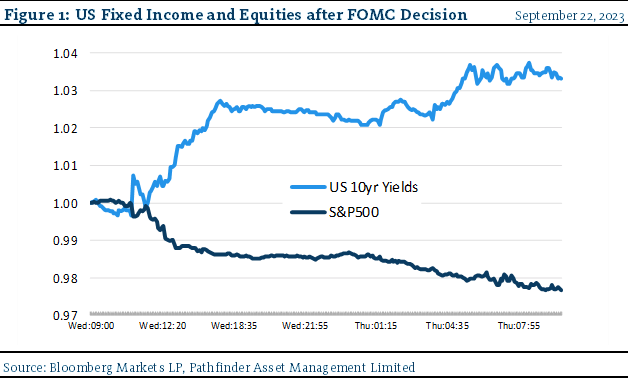How the FOMC Impacted the Market this Week
For some time now, investors have been trying to determine the trajectory of administered interest rates, as decided by the US Federal Open Market Committee (FOMC). The Federal Funds Target Rate has not been this high in over 20 years (since March of 2001). The FOMC has aggressively pushed target rates to this level to fight inflation and ultimately slow the economy. Investors in turn have been trying to determine if the current level is the “peak” and if the FOMC will start to reduce in time to produce a soft landing. This would ultimately be bullish for the economy and risk assets like stocks and commodities. On Wednesday, FOMC Chair Jerome Powell announced that the committee had decided to hold the Target Rate steady at 5.5%. This was expected. However, in his speech after the announcement, he indicated that the committee was inclined to raise one more time before the end of this year. This was not expected. It came as a shock to many investors who had assumed that the overnight rate was already at a peak:
- As a result, bond rates increased, and the stock market dropped. Please see Figure 1.
- Bond rates at various maturities jumped higher as investors assumed that the new rate would be carried into the system, slowing the economy which would result in more risk.
- Stocks went down because if rates are going up then the cost of capital increases for everyone. Profits are pinched from higher interest expense and consumers in general will spend less. Also, from a valuation perspective, the future value of the cash flow that is generated by all companies is worth a little bit less every time long-term bond rates increase. This causes investors to sell stocks.

“This means that” there is often a significant difference between what “the market” expects and what actually happens in the economy or an individual company. This disconnect is an opportunity for disciplined investors. In recent weeks, we have written about the substantial cash positions that our funds and mandates have on hand. These positions help to limit volatility but more importantly provide our portfolio managers the optionality to add more shares of good quality companies at better prices. We remain laser focused on our investment process.
National Instrument 31-103 requires registered firms to disclose information that a reasonable investor would expect to know, including any material conflicts with the firm or its representatives. Doug Johnson and/or Pathfinder Asset Management Limited are an insider of companies periodically mentioned in this report. Please visit www.paml.ca for full disclosures.
Changes in Leverage. We are increasing the asset ceiling to 2.0 times the market value of equity for Pathfinder International Fund and Pathfinder Real Fund to be consistent with Pathfinder Partners’ Fund and Pathfinder Resource Fund.
*All returns are time weighted and net of investment management fees. Returns from the Pathfinder Partners’ Fund and Partners’ Real Return Plus Fund are presented based on the masters series of each fund. The Pathfinder Core: Equity Portfolio and The Pathfinder Core: High Income Portfolio are live accounts. These are actual accounts owned by the Pathfinder Chairman (Equity) and client (High Income) which contain no legacy positions, cash flows or other Pathfinder investment mandates or products. Monthly inception dates for each fund and portfolio are as follows: Pathfinder Core: Equity Portfolio (January 2011), Pathfinder Core: High Income Portfolio (October 2012) Partners’ Fund (April 2011), Partners’ Real Return Plus Fund (April, 2013), and Partners’ Core Plus Fund (November 2014).
Pathfinder Asset Management Limited (PAML) and its affiliates may collectively beneficially own in excess of 10% of one or more classes of the issued and outstanding equity securities mentioned in this newsletter. This publication is intended only to convey information. It is not to be construed as an investment guide or as an offer or solicitation of an offer to buy or sell any of the securities mentioned in it. The author has taken all usual and reasonable precautions to determine that the information contained in this publication has been obtained from sources believed to be reliable and that the procedures used to summarize and analyze such information are based on approved practices and principles in the investment industry. However, the market forces underlying investment value are subject to sudden and dramatic changes and data availability varies from one moment to the next. Consequently, neither the author nor PAML can make any warranty as to the accuracy or completeness of information, analysis or views contained in this publication or their usefulness or suitability in any particular circumstance. You should not undertake any investment or portfolio assessment or other transaction on the basis of this publication, but should first consult your portfolio manager, who can assess all relevant particulars of any proposed investment or transaction. PAML and the author accept no liability of any kind whatsoever or any damages or losses incurred by you as a result of reliance upon or use of this publication.